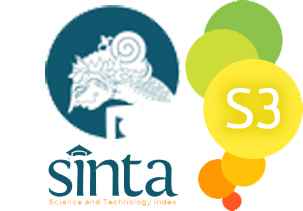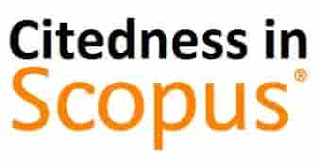Antibacterial Activity of Essential Oil of Basil Leaves (Ocimum Basilicum L.) And Kaffir Lime Leaves (Citrus Hystrix D.C) Combination Against Escherichia Coli ATCC 25922
Abstract
Basil essential oil has a component of linalool compounds belonging to terpenoid derivatives which have an antibacterial effect and essential oils of kaffir lime have citronella compounds which can inhibit the growth of various types of bacteria. This study aims to determine the antibacterial activity of essential oils of basil leaves, kaffir lime leaves and the combination of both against Escherichia coli bacteria ATCC 25922. This study has used diffusion methods to test antibacterial activity. The concentration of the sample was 2% and 4% with a ratio combination of essential oils were 1:1; 1: 2; 2:1. Then the research data were analyzed with two way Analysis of Variance (ANOVA). The results showed that essential oils in the combination of basil leaves (Ocimum basilicum L.) and kaffir lime leaves (Citrus hystrix D.C) had antibacterial activity against Escherichia coli ATCC 25922 with concentrations of 2% and 4%. Variations of essential oils from basil (Ocimum basilicum L.) leaves and kaffir lime (Citrus hystrix D.C) leaves with a ratio of 1:2 at a concentration of 4% has the greatest inhibitory potential against Escherichia coli ATCC 25922 with inhibition diameters of 15.5 mm.
References
Akthar MS, Degaga B, Azam T. 2014. Antimicrobial activity of essential oils extracted from medicinal plants against the pathogenic microorganisms: A review. Biological Sciences and Pharmaceutical Research. Vol.2 (1), 001-007.
Badan Standarisasi Nasional. (2009). Batas Maksimum Cemaran Mikroba dalam pangan. SNI:7388.
Bilal A, Jahan N, Ahmed A, Bilal SN, Habib S & Hajra S. (2012). Phytochemical and pharmacoloigical Studies on Ocimum basilicum Linn- A Review. IJCRR 4 (23): 73-83.
Bonang G, Koeswardono ES. (2004). Mikrobiologi Kedokteran untuk Laboratorium dan Klinik. Jakarta: Bagian Mikrobiologi Fakultas Kedokteran Universitas Indonesia.
Dhulgande, G., A.R.Birari & D.A. Dhale. (2010). Preliminary Screening ofAntibacterial and Phytochemical Studies of Ocimum americanum Linn. Journal of Ecobiotechnology, 2 (8) : 11-13.
Gunawan Hadipoenyanti E & Wahyuni. S. (2008). Keragaman Selasih (Ocimum Spp.) Berdasarkan Karakter Morfologi, Produksi dan Mutu Herba. Bandung: ITB. Hal 141-148.
Gunawan D, Mulyani S. (2004). Ilmu Obat Alam (Farmakognosi). Jilid 1. Jakarta: Penebar Swadaya.
Hadipoentyanti, Endang.,& Wahyuni, Sri. (2008). Keragaman Selasih (Ocimum spp.) Berdasarkan Karakter Morfologi roduksi dan Mutu Herbal, Jurnal Litri, Vol(4).
Jamaluddin N, Pulungan MH, Warsito. (2017). Uji Aktivitas Antibakteri Minyak Atsiri Jeruk Purut (Citrus hystrix DC) terhadap Klebsiella pneumoniae ATCC. Industria: Jurnal Teknologi dan Manajemen Agroindustri Vol 6 No 2: 61-66
Jawetz, Melnick, J.L., and Adelberg, E.A. (2007). Medical Microbiologi 24th edition. USA: Mc-Graw Hill companies.
[Kemenkes RI] Kementerian Kesehatan Republik Indonesia. (2017). Profil Kesehatan Indonesia Tahun 2017. Jakarta: Kementerian Kesehatan Re publik Indonesia.
Mariyati, Ratna SF dan Triastuti R. (2007). Uji aktivitas Antibakteri Minyak Atsiri Daun Kemangi (Ocimum basilicum L.) Terhadap Staphylococcus aureus Dan Escherichia Coli. Jurnal Penelitian Sains & Teknologi 8.
Martono BE, Hadipoentyanti dan L Udarno. (2004). Plasma Nuftah Insektisida Nabati. Perkembangan. Teknologi TRO XVI.
Maruti J, Dhanavade, Chidamber B, Jalkute, Jai S, Ghosh and Kailash D, Sonawane. (2011). Study Antimicrobial Activity of Lemon (Citrus lemon L.) Peel Extract. British Journal of Pharmacology and Toxicology 2(3): 119-122.
Oktalia. (2009). Kapita Selekta Dispending I. Yogyakarta: UGM Press.
Ramesh B & Satakopan V N. 2010. In Vitro Antioxidant Activities Ocimum Species: Ocimum basilicum and Ocimum Sanctum, Journal Of Cell and Tissue Research 10. 1: 2145-2150.
Silva VA, Sousa, JP, Guerra FQS , Pessôa HLF, Freitas AFR, Alves LBN, Lima EO. (2015). Antibacterial Activity of Ocimum basilicum Essential Oil and Linalool on Bacterial Isolates of Clinical Importance. International Journal of Pharmacognosy and Phytochemical Research; 7(6); 1066-1071.
Taechowisan T, Jantiya J, Mungchukeatsakul N, and Phutdhawong WS. (2018). Major Compounds from Ocimum basilicum L. and their Antimicrobial Activity against Methicillin-Resistant Staphylococcus aureus. Biomed J Sci & Tech Res 3(3). BJSTR.MS.ID.000910.
Yuliani, R., Peni, I., dan Septi, S. R. (2011). Aktivitas Antibakteri Minyak Atsiri Daun Jeruk Purut (Citrus hystrix) terhadap Staphylococcus aureus dan Escherichia coli. Journal Pharmacon 12(2): 50 – 4.























